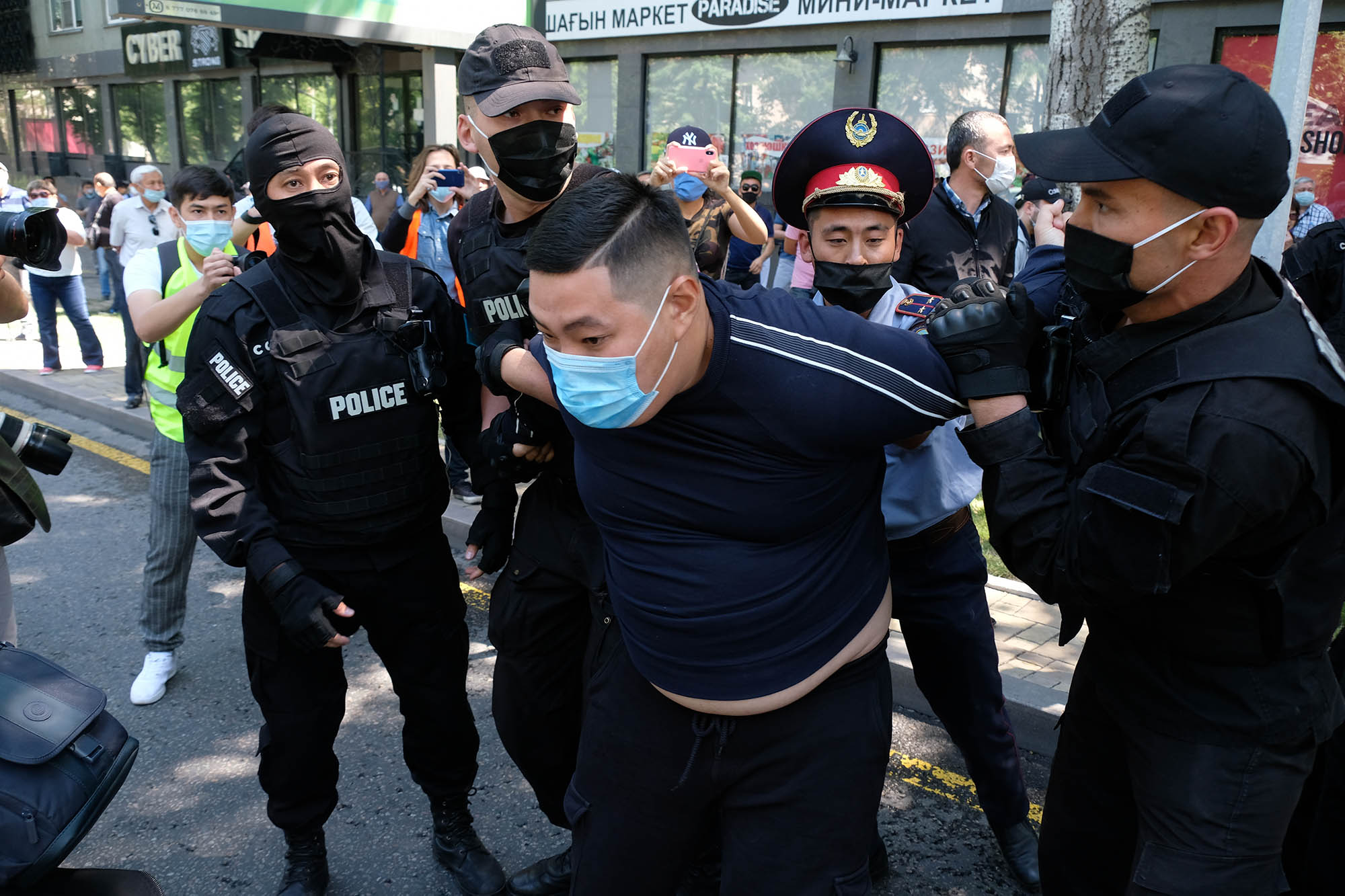Resources for Understanding Events in Kazakhstan
Are you looking for more context on unfolding events in Kazakhstan? Below is a list of books, reports and articles on various aspects on Kazakhstan’s politics.
Diana Kurdaibergenova, Toward Nationalizing Regimes Conceptualizing Power and Identity in the Post-Soviet Realm (University of Pittsburgh Press, 2019)
Using case studies from Latvia and Kazakhstan, the book seeks to better understand the phenomenon of post-Soviet states tapping into nationalism to build legitimacy. Nationalizing Regimes provides a framework of top-down structures of decision-making and policies where political elites’ competition defines the outcome of nation-building strategies. In the latter part of the book she examines how non-elites – citizens and non-citizens respond to these imaginations of nations where the state is overshadowed by the “regime.”
Dina Sharipova, State-Building in Kazakhstan: Continuity and Transformation of Informal Institutions (Lexington, 2018).
Sharipova explores how limited access to state benefits has stimulated people’s engagement in informal reciprocal relations. She investigates informal channels and mechanisms people use to gain access to quality public goods—education, housing, and healthcare.
Joanna Lillis, Dark Shadows: Inside the Secret World of Kazakhstan (I.B. Tauris, 2018)
Journalist Joanna Lillis paints a vibrant picture of this emerging nation through vivid reportage based on 13 years of on-the-ground coverage. Lillis charts almost 30 years of Kazakhstan’s history, exploring how Nazarbayev consolidated his power, how the elite made billions of dollars from the country’s resource wealth and how citizens started to become angry, with a chapter focusing on Zhanaozen, where the present protests began.
Erica Marat. The Politics of Police Reform: Society against the State in Post-Soviet Countries (Oxford University Press, 2018).
Marat examines the process of police reform in five countries, including Kazakhstan. She examined how in Kazakhstan following the Zhanaozen events of 2011, a case of what she terms “transformative violence,” Kazakhstan deepened authoritarianism by upgrading policing in rural areas to improve intelligence gathering on the local population in order to predict the rise of any antigovernment activities.
Balihar Sanghera and Elmira Satybaldieva, Rentier Capitalism and Its Discontents Power, Morality and Resistance in Central Asia (Palgrave 2021).
A recent book examining how neoliberal reforms in Kyrgyzstan and Kazakhstan have created inequalities and generated resistance. Through examples of rentierism through financial institutions, property development and resource extraction, they detail the the emergence of new class relations and countermovements.
Marlene Laruelle (ed)., The Nazarbayev Generation: Youth in Kazakhstan (Lexington, 2019).
Over half of Kazakhstan’s population was born since 1991. They have no direct memory of the Soviet regime, only family recollections. The collection of essays explore the diversity of the country’s younger generations and the transformations of social and cultural norms that have taken place over the course of three decades of independence.
Kazakhstan: Tested by Transition (Chatham House, 2019).
A group for experts consider the challenges facing Kazakhstan’s economy, politics and foreign policy in the wake of Tokayev taking over as president in March 2019.
Retreating Rights- Kazakhstan (Foreign Policy Centre, 2021).
A group of essays on human rights issues in Kazakhstan, including police kettling, suppression of labor unions, digital censorship and the impact of Covid-19.
Marlene Laruelle (ed.) Kazakhstan in the Making. Legitimacy, Symbols and Social Changes (Lexington 2015).
A selection of essays on life, politics, culture and society in Kazakhstan. Particularly relevant chapters are Assel Tutumlu on “Rule by Law” in Kazakhstan, Sebastien Peyrouse on the country’s “neopatrimonial” regime and Diana Kudaibergenova and Marlene Laruelle’s chapters on national identity.
Henry Hale, Patronal Politics Eurasian Regime Dynamics in Comparative Perspective (Cambridge University Press 2014)
A key text for understanding how corruption, rent-seeking and patron-client relationships shape regime dynamics in Eurasia, in some cases helping rulers solidify their grip on power and in other cases causing their downfall.
Edward Schatz, Modern Clan Politics: The Power of” Blood” in Kazakhstan and Beyond (University of Washington Press, 2004)
Edward Schatz explores the politics of kin-based divisions in Kazakhstan. Asking why kinship divisions do not fade from political life with modernization, he shows that the state actually constructs clan relationships by infusing them with practical political and social meaning.
Alexander Cooley and John Heathershaw. Dictators without Borders: Power and Money in Central Asia, (Yale University Press, 2017).
The book charts how Central Asia’s elites have relied on offshore tax havens in the “West” to conceal billions of dollars of ill-gotten gains. In doing so, they challenge the notion that Central Asia is isolated and irrelevant to the outside world. The example of Mukhtar Ablyazov, who served in Kazakhstan’s government during the 1990s and in 2005 became chairman of the country’s largest financial institution BTA Bank, is illustrative. With the help of Western brokers, he used his position to embezzle billions of dollars through a range of offshore schemes. When the bank collapsed, Ablyazov fled to London to claim political asylum.
Secretive Offshore Maneuvers Enriched Unofficial Third Wife of Kazakhstani Leader Nursultan Nazarbayev (OCCRP 2021)
The report documents how the unofficial third wife of Kazakhstan’s former president Nursultan Nazarbayev received $30 million.
Collecting Beetles in Zhanaozen: Kazakhstan’s Hidden Tragedy (Open Democracy 2021)
An interview with novelist Yrysbek Dabei, who wants his country to confront a mass killing of striking workers in Zhanaozen in 2011.
Nations in Transit 2021- Kazakhstan
Freedom House’s annual review of political freedoms touches on civil society, corruption, justice, the media, elections, local and national governance.
Mass Spectacle and Styles of Governmentality in Kazakhstan and Uzbekistan by Laura Adams and Assel Rustemova (2009)
Rustemova and Adams describe how power relations manifest in each country, and to interpret how the differences influence various symbols and practices with a focus on holiday celebrations in particular. They argue that Kazakhstan’s style of governmentality is more technocratic, forward-looking and managerial.
The Soft Authoritarian Tool Kit: Agenda-Setting Power in Kazakhstan and Kyrgyzstan by Edward Schatz (2009)
While authoritarianism has become “hard” in Kazakhstan in recent years, Schatz’s 2009 piece demonstrates how in the first two decades of independence Kazakhstan’s government opted to maintain control by modernizing the economy, reducing the need for repression. He argues soft authoritarianism is effective when it succeeds in making good use of the state’s means of persuasion. These days are now over.
Untangling the Puzzle of “Russia’s Influence” in Kazakhstan by Marlene Laruelle, Dylan Royce & Serik Beyssembayev (2019)
The article unpacks Russia’s influence in Kazakhstan. It covers Russia’s economic and strategic links with Kazakhstan, the issue of the Russian minority, the status of the Russian language, Russian media presence, Russia’s governmental and non-governmental networks, and the “payoff” of the latter three vectors: Kazakhstani popular Russophilia.
Theorizing the Nature of Power in Central Asia, edited by Diana T. Kudaibergenova & Filippo Costa Buranelli (2021)
This recent special issue in Problems of Post-Communism contains a number of reflections on how best to understand different power dynamics in Central Asia. Of particular relevance to understanding current events are:
The Paradox of Authoritarian Power: Bureaucratic Games and Information Asymmetry. The Case of Nazarbayev’s Kazakhstan by Assel Tutumlu & Ilyas Rustemov (2021)
The authors use Nursultan Nazarbayev’s Kazakhstan to analyze the inability of the ruler to conduct effective oversight when officials engage in elaborate personality cults, depoliticization, and informal patronal practices that threaten the market and the legitimacy of the ruler.
Nightmarizing States: Affective Encounters with Counter-Extremism in Kazakhstan by Maurizio Totaro
The article focuses on anti-terror simulations and the performance of a theater play in the city of Aqtau, near where the recent protests started. Totaro argues that encounters with security measures and performances are formative moments for people’s apprehension of “the threat” of terrorism and “the state” through the circulation of emotions, lending a visceral dimension to the understanding of (in)security.
The Protests in Zhanaozen and the Kazakh Oil Sector: Conflicting Interests in a Rentier State by Dossym Satpaev and Тolganay Umbetaliyeva (2015)
The article analyzes the impact of the oil and gas industry on the socio-political stability in Kazakhstan. It examines how Kazakhstan’s rentier state generates tensions through the case study of protests in Zhanaozen in 2011.
The Contributions of New Media to Young People’s Political Participation in Russia and Kazakhstan by Yerkebulan Sairambay (2021)
Drawing on data collected during one year of fieldwork that included online surveys, interviews and focus groups with young people in both Russia and Kazakhstan, this study demonstrates that new media contribute to both on- and offline political participation in Russia and Kazakhstan among young people through: awareness as a prerequisite for political participation; communication; interaction; advocacy as political participation; mobilization; organizing; coordination; and hype-ization.
Labor Unions and Institutional Corruption: The Case of Kazakhstan by Slyamzhar Akhmetzharov, Serik Orazgaliyev (2021)
In this study, the authors used the institutional corruption framework to analyze the evolution of labor unions in Kazakhstan. They combined document analysis with survey data covering (n)1,200 respondents across all 14 regions of the country. Their findings suggest that external and internal influences weakened labor unions and diverted them from fulfilling their primary purpose of promoting interests of their members. External influences, represented by restrictive regulatory framework and state intervention, create conditions of limited independence of labor unions leaving them extremely narrow scope to operate in. Internal influences are represented by disagreements and conflicts between national-level labor unions.
Rethinking Transfers of Power and Public Protest in Kazakhstan, 1959–1989 by Nari Shelekpayev (2021)
The article examines two Soviet-era protests in Kazakhstan: the uprising in Temirtau in 1959 and the so-called December events (referred to as ‘Zheltoqsan’) in Almaty and other cities in Kazakhstan in 1986. It explores how these events are remembered and the role they played in Kazakhstan achieving independence in 1991.
The Central Asia Protest Tracker
An interactive database of over 2,500 protests in the region since 2018, it charts the rise in protests in Kazakhstan since 2019, driven by a disappointing transition of power, economic problems and rising inequality.
Access the data here: https://oxussociety.org/viz/protest-tracker/
Read the reports about the project here and here.




